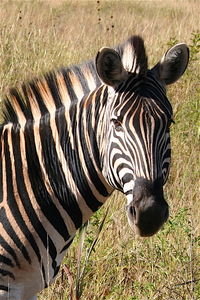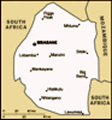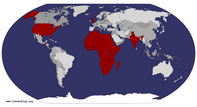Advertisement
Published: June 16th 2008
[youtube=lEXqTmn5WMA][youtube=FtYotxbwTUQ][youtube=kf0zQRcIOmk][youtube=ighNF8sXKHQ][youtube=l9IvUWawW2w]

 SWAZI ZEBRA
SWAZI ZEBRA
Mlilwane Wildlife SanctuaryTHE KINGDOM OF SWAZILAND:
HIPPOS COME TO DINNER, WARTHOGS AT THE CAMPFIRE
“When King Sobhuza II died at age 83, he left about 120 wives,
with unofficial estimates putting the number of wives and mistresses
at more than double this number. The current King Mswati III has 13
wives. The King was the center of controversy in 2001 when he married
a 17 year old, two months after imposing a five year sex ban on the
Kingdom’s teenage females. The “forced” chastity was imposed
to fight the spread of HIV/AIDS. He ended the ban a year early.”
Lonely Planet
We enter Swaziland from South Africa and immediately I feel a different vibe. The Swazi man at the immigration counter is more interested in asking me about Barack Obama than he is about inspecting my Passport. The land lacks the look of agribusiness. There are no huge irrigated fields. Round thatched huts pop up like mushrooms all over the rolling landscape.
Andre has already told us the stories (see the Kruger blog). During the apartheid years in South Africa white men who had fallen in love with black women would drive to the Swazi

 SWAMI KRISTENANDA
SWAMI KRISTENANDA
Mosquito net cloud in the rondavalborder in separate cars, enter Swaziland individually, and then enjoy the freedom in Swaziland that did not exist in South Africa. “Not exist” is perhaps too mild a definition. The white man would have been jailed for such cross-racial relations. For the black woman jail might have been the preferred alternative, compared to her actual punishment. Read the transcripts from the Truth and Reconciliation Commission.
It is perhaps only simple logic that would lead one to believe that the South African people of color, raised under the incredible cruelty of the apartheid system, and those raised in Swaziland who did not suffer that same level of oppression, would be black Africans of a completely different nature. I myself find this to be so, although my evidence is purely anecdotal and non-measurable. I find the black and coloured people (although certainly not exclusively) of South Africa, at least in the Western Cape, to be meek and almost subservient, whereas the ones I met in Botswana and Swaziland present themselves in a more self-confident and self-assured manner. I would in no way suggest that there is not oppression and racism in Botswana and Swaziland. These countries had their own struggles for

 HIPPOS ON THE BEACH
HIPPOS ON THE BEACH
Early morning basking at Mlilwaneindependence from British colonialism. But the racism and oppression was not systematically practiced to the bizarre extent that it was in South Africa.
I would gladly accept a challenge to this perception, one that may illuminate me further. But I have also heard concurrent opinions presented by black South Africans, similar to ones presented in the Black Consciousness Movement during the struggle to bring an end to apartheid. Read Steve Biko.
The other thing I found interesting as we drove through Mbabane, the capital of Swaziland, was the virtual absence of white people on the streets. None in fact. I remember noting this as well when we watched a documentary on Ghana, where the camera scanned the crowds and picked up nary a white face. This might seem to be stating the obvious to some, because we are, after all, in Africa. But South Africa is a different creature. Some say it is not Africa, but I say it is Africa to the core, simply a much more complicated version of the continent.
Sociology and politics science aside, we now drive through an incredible expanse of mountainous countryside and smallholdings of cattle and sheep. Men and women
are selling little bundles of firewood on the side of the ride. Their little fires incense the cool air. I have already decided that when I want to disappear, this will be the place where I will go.
In the late afternoon we arrive at our destination.
Unlike Kruger, there are no predators where we have landed in Swaziland. The Mlilwane Wildlife Sanctuary is free of lions and leopards. This means, thankfully, that we can leave the car parked and hike on the beautiful trails that are carved through this place without fear of an encounter with a two hundred pound feline that loves to eat fresh meat. This does not mean, however, that it’s tantamount to a stroll through the Botanical Gardens. We figure this out quickly after seeing a few notices posted in the office:
“HIPPOS ARE RESPONSIBLE FOR MORE HUMAN DEATHS ANNUALLY THAN ANY OTHER LARGE ANIMAL IN AFRICA.”
Hmmmm.
“CROCODILES CAN JUMP TWO METERS. PLEASE STAND BACK FROM THE RAILING.”
OK.
Then I read the following bit of illuminating literature that sheds interesting light on the aforementioned data:
“While it is true that in Africa the hippo is

 OUR LODGINGS IN SWAZILAND
OUR LODGINGS IN SWAZILAND
Rondaval at the Wildlife Sanctuaryresponsible for more human deaths annually, worldwide it is the crocodile that is responsible for more human deaths annually.”
Great. This place has both. And I don’t see a fence. How would you like to die?
We arrive at the Mlilwane Wildlife Sanctuary in the Ezulwini Valley of Swaziland at sunset. Our thatched rondoval sits on a little ridge overlooking a marshy field. Mountains are silhouetted to the west. Just below us antelope are grazing. It’s immediately apparent that this is indeed a “sanctuary.” These beautiful animals show absolutely no fear.
We are told that after dark it’s best to walk only directly from our rondoval to the bar and the dining area. Which is what we do. Hippos come out of the water at night. I’m not sure about crocs. I must read up on that.
The campfire just outside the large thatched enclosure glows red in the darkness. Its smoke rises as straight as a white line drawn on a blackboard. The temperature is relatively chilly tonight, maybe 7 degrees (45 F), so we happily walk into the warmth that radiates from the burning logs.
Suddenly there’s loud angry snorting, and a big

 FROM OUR FRONT DOOR
FROM OUR FRONT DOOR
Dawn, mist and mountainscreature jumps up next to the fire in a cloud of dust. He takes a few not so tentative steps towards us but stops when he sees that we are scared shitless and are clearly in the flight and not fight mode. Oh come on, I think, stop with this genuine African experience. I’ve already had a few palpitations on the drive here, and I don’t know about you, but to me the words atrial fibrillation and Swaziland don’t sound too comforting when used in the same sentence.
My God, it’s a toothy, ugly, muscular, low slung warthog that has snuck into camp and has nestled up to the fire. And he wants it all to himself. Talk about sanctuary!
In the dining room, after my heart rate dips below100, we eat impala chops and chicken curry served by waitresses wearing gloves, fleece jackets and woolen hats. It’s not THAT cold in there, but we find that the Africans really bundle up when the temp plunges below 16 degrees (60F). There’s another Dutch couple in there and us, that’s it. The dining room overlooks a large pond, and we see more signs that warn us about the crocs

 LAKE IN SWAZILAND
LAKE IN SWAZILAND
From the Maguga Dam on the drive to Mlilwanethat, unlike white men, can leap.
In the morning, after I share our front yard with two bush pigs, we eat outside in the sun, close, but not too close, to the railing. I’m guessing that crocs probably like bacon and sausage. After breakfast we take a drive with one of the rangers in the open Land Rover to get an idea of how the park is laid out. It’s not nearly as big as Kruger. Mlilwane is to Kruger as Rhode Island is to Texas. But we learn a lot. I now know the gestation period of a blesbok antelope, and can tell the age of an impala by reading the curve of his horns. I will certainly use that information when I return to the United States. Some hippos are still out of the water lounging in the morning light, blinking lazily, and flicking their little ears. Crocodiles lie on islands, motionless, their mouths wide open, drinking in the sun’s warmth.
In the afternoon we take off on the “Hippo Trail” and are able to walk amazingly close to zebra, antelope, water buffalo, and yes, crocodile. The crocs are offshore, on little islands, sunning themselves like
retirees on Miami Beach. The trail winds through gloriously shaded corridors of moss-covered trees, along running creeks, then out into the open spaces where the sun slants in the late afternoon. The sky is clear, and the temperature falls quickly.
In the evening we eat outside once again. The resident warthog is snuggled up to the fire, and we know enough not to disturb him. He is perhaps, in this tame African bush reality, more like Lassie than a warthog, although I doubt very much that he would sit on command. While I am gnawing on a particularly tasty lamb chop we hear noises emerging from the darkness, a sloshing sound out there in the water beyond the railing. Kristen shines her flashlight out into the depth of night and what we see is stunning. There are two enormous hippos about 50 meters away, walking chest deep through the water on their way to some delicious field of grass where they will forage away the night. It dawns on us - where did they come from? They had to pass right by our rondoval. I take a big swig of the Cabernet and return to the chops. We follow
our main course with a poached pear, which is in fact delicious, but I’m a bit preoccupied with the hippo. What was that statistic again? We have a morbid aperitif conversation about which newspapers would cover the death of a Cape Cod man nailed by a hippo in Swaziland. I’m sure the Boston Globe or maybe even the New York Times would pick it up. Kristen feels it wouldn’t get as far as the Cape Cod Times. We both agree that the Voice is a no-brainer. Death by atrial fibrillation would go nowhere I’m afraid. How mundane compared to: “WELLFLEET MAN CRUSHED BY HIPPO.” I must say it would be a very theatrical way to go, and despite the awful panic that I would undoubtedly feel during the assault, I believe it might be a great way to exit. I think you would get great reincarnation points for this. I must remember to ask Mr. Dalai when I speak to him next time.
We retire to our rondoval after this illuminating conversation and read while wrapped in the cloud of mosquito netting that drapes over our bed. We light the kerosene lamp and display the stunning Swazi baskets that we bought yesterday from the women’s cooperative at the top of Pigg’s Peak. They somehow resemble the ceiling of the rondoval, beautiful concentric rings and repetitive patterns of thatch and straw.
Outside there is the snorting of blesbok and waterbuck as they bed down for the night. I might even hear warthog and bushpig rooting around out there as well. We know now that the hippos will be lumbering by on their way back to their daytime underwater positions after feasting through the night. We won’t get in their way.
In the morning the sun rises into an electric blue sky. A blanket of mist has settled on the marsh in front of our hut and the mountains beyond are a salmon red. Antelope are moving in the distance. We see our breath cloud out in big exhales of wonderment.
At breakfast we watch herons swoop down from the trees like ancient pterodactyls. The water is coffee brown and as motionless as a mirror. We ache to see a crocodile slither into the water. An aerial assault wouldn’t be bad either.
“WELLFLEET MAN TAKEN BY CROCODILE IN SWAZILAND.”
That would make it to CNN, I’m sure.
Advertisement
Tot: 0.168s; Tpl: 0.011s; cc: 14; qc: 68; dbt: 0.081s; 1; m:domysql w:travelblog (10.17.0.13); sld: 1;
; mem: 1.2mb











Martin
non-member comment
cold nights
I leave for Swaziland on sunday and i'm thinking i may not have packed enough clothes. I have no room left in my rucksack though! Is there plenty of clothing available locally?